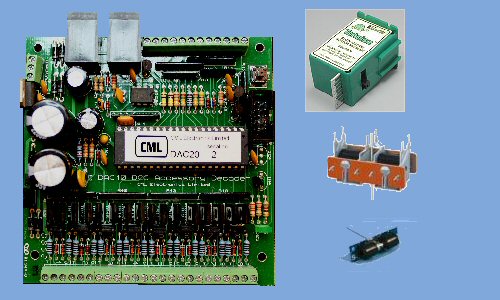All of the points on the railway are DCC operated. This is vital for computer control: the computer needs to be able to set the track to the necessary position for any train movement.
I've used CML Electronics DAC20 accessory decoders. The DAC20 controls up to 8 point motors of most types. The common "Peco" and "Seep" solenoid motors work well with the DAC20, and I've used those extensively. Both need a capacitor discharge power unit, and that is included on the DAC20 board. The DAC20 boards all have an auxiliary 24v supply.

On this railway, all that is needed now is a simple accessory decoder function. The DAC20 can also do automatic control of semaphore signals, and control lighting circuits; these may be added to the railway later.
The DAC20 has a LocoNet interface: this means that it can report the point state to LocoNet after power up. This way, all other devices - e.g. signal controllers - will "know" the state of all of the points automatically.
We have used several different kinds of point motor:
- The early points were all controlled by Seep point motors. These are fairly low cost, and have an integral switch. I have had a couple fail (one disintegrated, an done had a rough edge to the switch contact on its PCB which "snagged" occasionally). Also I've had the switch contact become unreliable, but this has always been resolved with a squirt of switch cleaner. I'm wondering if flux ran on to the PCB while soldering wores and connector pins.
- Clanfield station uses Tortoise type point motors. There are fairly expensive, but absolutely reliable. "You get what you pay for" some say.... they are als very bulky, and on the track sections with trains running underneath there's no way they would fit.
- One point is mounted very close to the timber frame, and we tried a Peco point motor plus microswitch. This has proved unreliable: my experience with these is that eventually they stop sliding across because of mechanical friction. WD40 may resolve it..... but I've replaced it with a "Cobalt" motor from DCC Concepts. This is like a Tortoise, but smaller.
- I have purchased a number of "Conrad" motors for areas where train run underneath. Not tried them yet. The DAC20 will need an output adapter for those.
